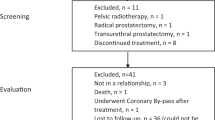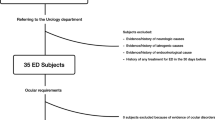Abstract
Extracorporeal treatment with low intensity shock-wave therapy (LI-ESWT) is a recently introduced non-invasive method which purposes the restoration of the pathophysiological alterations at the base of vasculogenic ED in male patients. The evidence in favour of the neoangiogenic potential of this treatment derived from in vitro studies and on animal models. The purpose of this study, in which the Power Doppler method was applied, is to demonstrate ‘objectively’ the real efficacy of LI-ESWT at the level of the microcirculation of the corpora cavernosa (neoangiogenesis) in patients affected by vasculogenic ED. Data from this study show, for the first time, that LI-ESWT treatment promotes neovascularisation of the functional arteries in patients affected by vasculogenic ED.
This is a preview of subscription content, access via your institution
Access options
Subscribe to this journal
Receive 8 print issues and online access
$259.00 per year
only $32.38 per issue
Buy this article
- Purchase on Springer Link
- Instant access to full article PDF
Prices may be subject to local taxes which are calculated during checkout



Similar content being viewed by others
References
Khanzada U, Khan SA, Hussain M, Adel H, Masood K, Adil SO, et al. Evaluation of the causes of erectile dysfunction in patients undergoing penile doppler ultrasonography in Pakistan. World J Mens Health. 2017;35:22–7.
Sullivan ME, Keoghane SR, Miller MAW. Vascular risk factors and erectile dysfunction. BJU Int 2001;87:838–45.
Varela CG, Yeguas LAM, Rodríguez IC, Vila MDD penile doppler ultrasound for erectile dysfunction: technique and interpretation. Am J Roentgenol 2020;1-10.
Klingler HC, Kratzik C, Pycha A, Marberger M. Value of power Doppler sonography in the investigation of erectile dysfunction. Eur Urol 1999;36:320–26.
Sakamoto H, Shimada M, Yoshida H. Hemodynamic evaluation of the penile arterial system in patients with erectile dysfunction using power Doppler imaging. Urology. 2002;60:480–84.
Sarteschi LM, Montorsi F, Fabris FM, Guazzoni G, Lencioni R, Rigatti P. Cavernous arterial and arteriolar circulation in patients with erectile dysfunction: a power Doppler study. J Urol 1998;159:428–32.
Vardi Y, Appel B, Jacob G, Massarwi O, Gruenwald I. Can low-intensity extracorporeal shockwave therapy improve erectile function? A 6-month follow-up pilot study in patients with organic erectile dysfunction. Eur Urol 2010;58:243–8. https://doi.org/10.1016/j.eururo.2010.04.004. Epub 2010 May 6
Kalyvianakis D, Hatzichristou D. Low-intensity shockwave therapy improves hemodynamic parameters in patients with vasculogenic erectile Dysfunction: a triplex ultrasonography-based sham-controlled trial. J Sex Med. 2017;14:891–7.
Sokolakis I, Dimitriadis F, Teo P, Hatzichristodoulou G, Hatzichristou D, Giuliano F. The basic science behind low-intensity extracorporeal shockwave therapy for erectile dysfunction: a systematic scoping review of pre-clinical studies. J Sex Med 2019;16:168–94.
Wang CJ, Wang FS, Yang KD, Weng LH, Hsu CC, Huang CS, et al. Shock wave therapy induces neovascularization at the tendon–bone junction. A study in rabbits. J Orthop Res 2003;21:984–89.
Nishida T, Shimokawa H, Oi K, Tatewaki H, Uwatoku T, Abe K, et al. Extracorporeal cardiac shock wave therapy markedly ameliorates ischemia-induced myocardial dysfunction in pigs in vivo. Circulation. 2004;110:3055–61.
Kikuchi Y, Ito K, Ito Y, Tsuburaya R, Aizawa K, Hao K, et al. Double-blind and placebo-controlled study of the effectiveness and safety of extracorporeal cardiac shock wave therapy for severe angina pectoris. Circulat J 2010;74:589–91.
Sokolakis I, Hatzichristodoulou G. Clinical studies on low intensity extracorporeal shockwave therapy for erectile dysfunction: a systematic review and meta-analysis of randomised controlled trials. Int J Impot Res 2019;31:177–94.
Sikka SC, Hellstrom WJ, Brock G, Morales AM. Standardization of vascular assessment of erectile dysfunction: standard operating procedures for duplex ultrasound. J Sex Med 2013;10:120–29.
Dayan L, Greunwald I, Vardi Y, Jacob G. A new clinical method for the assessment of penile endothelial function using the flow mediated dilation with plethysmography technique. J Urol 2005;173:1268–72.
Souper R, Hartmann J, Alvarez M, Fuentes I, Astroza G, Marconi M. Correlation between peak systolic velocity and diameter of cavernosal arteries in flaccid versus dynamic state for the evaluation of erectile dysfunction. Int J Impot Res 2017;29:132–35.
Cavallini G, Scroppo FI, Zucchi A. Peak systolic velocity thresholds of cavernosal penile arteries in patients with and without risk factors for arterial erectile deficiency. Andrology. 2016;4:1187–92.
Frey A, Sonksen J, Fode M. Low-intensity extracorporeal shockwave therapy in the treatment of post-prostatectomy erectile dysfunction: a pilot study. Scand J Urol. 2016;50:123–7.
Campbell JD, Trock BJ, Oppenheim AR, Anusionwu I, Gor RA, Burnett AL. Meta-analysis of randomized controlled trials that assess the efficacy of low-intensity shockwave therapy for the treatment of erectile dysfunction. Ther Adv Urol 2019;11:1756287219838364.
Pan MM, Raees A, Kovac JR. Low-intensity extracorporeal shock wave as a novel treatment for erectile dysfunction. Am J Men’s Health. 2016;10:146–48.
Lu Z, Lin G, Reed-Maldonado A, Wang C, Lee YC, Lue TF. Low-intensity extracorporeal shock wave treatment improves erectile function: a systematic review and meta¬analysis. Eur Urol 2017;71:223–33.
Vardi Y, Appel B, Kilchevsky A, Gruenwald I. Does low intensity extracorporeal shock wave therapy have a physiological effect on erectile function? Short-term results of a randomized, double-blind, sham controlled study. J Urol 2012;187:1769–75.
Kitrey ND, Gruenwald I, Appel B, Shechter A, Massarwa O, Vardi Y. Penile low intensity shock wave treatment is able to shift PDE5i nonresponders to responders: a double-blind, sham controlled study. J Urol 2016;195:1550–55.
Yamaçake KG, Carneiro F, Cury J, Lourenço R, Françolin PC, Piovesan AC, et al. Low-intensity shockwave therapy for erectile dysfunction in kidney transplant recipients. A prospective, randomized, double blinded, sham-controlled study with evaluation by penile Doppler ultrasonography. Int J Impot Res 2019;31:195–203.
Zewin TS, El-Assmy A, Harraz AM, Bazeed M, Shokeir AA, Sheir K, et al. Efficacy and safety of low-intensity shock wave therapy in penile rehabilitation post nerve-sparing radical cystoprostatectomy: a randomized controlled trial. Int Urol Nephrol 2018;50:2007–14.
Author information
Authors and Affiliations
Corresponding author
Ethics declarations
Conflict of interest
The authors declare that they have no conflict of interest.
Additional information
Publisher’s note Springer Nature remains neutral with regard to jurisdictional claims in published maps and institutional affiliations.
Rights and permissions
About this article
Cite this article
Scroppo, F.I., Pezzoni, F., Gaeta, F. et al. Li-Eswt improves hemodynamic parameters thus suggesting neoangiogenesis in patients with vascular erectile dysfunction. Int J Impot Res 34, 237–242 (2022). https://doi.org/10.1038/s41443-021-00411-0
Received:
Revised:
Accepted:
Published:
Issue Date:
DOI: https://doi.org/10.1038/s41443-021-00411-0
This article is cited by
-
News and future perspectives of non-surgical treatments for erectile dysfunction
International Journal of Impotence Research (2023)



